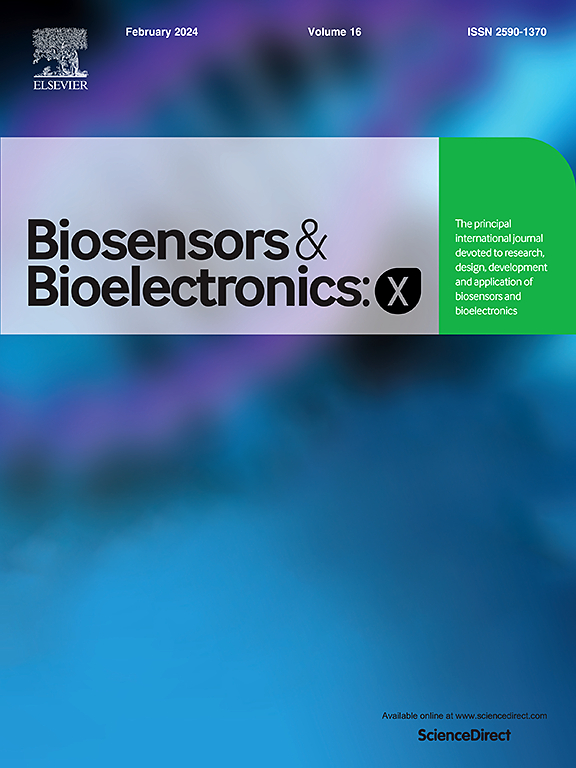一种用于监测CRISPR/Cas活性的电解门控晶体管
IF 10.61
Q3 Biochemistry, Genetics and Molecular Biology
引用次数: 0
摘要
核糖核酸(RNA)的检测是鉴定人类和动物中病毒或细菌感染的关键步骤。逆转录聚合酶链式反应(RT-PCR)仍然是金标准,但与Cas核糖核酸内切酶颗粒(CRISPR/Cas)相关的聚集规律间隔短回文重复序列最近彻底改变了两种rna的识别步骤,即CRISPR- rna (crRNA)和靶标,与RT-PCR所基于的裸杂交相比,提供了更好的选择性。在这里,我们将CRISPR/Cas13a系统的高效率与电解质门控石墨烯场效应晶体管(EGGFET)的转导和扩增能力结合起来,用于检测特定的RNA序列。在这些装置中,制造在柔性塑料衬底上,活性材料(还原氧化石墨烯,rGO)通过印刷沉积,然后用装饰有polyU RNA报告链的金纳米粒子进行功能化。在该系统中,CRISPR/Cas13a复合物作为催化剂:在特定RNA靶序列存在的情况下,酶功能被激活,polyU RNA报告链从Au纳米颗粒上被切割,诱导还原氧化石墨烯层上的负电荷损失。这种现象导致晶体管的传递曲线发生可测量的变化。这些传感器用于检测SARS-CoV-2 RNA序列,在10−7 ~ 102 ng μL−1范围内显示出线性响应,估计检测限为10 fM。这项工作是下一代即时RNA传感器发展的一个重要里程碑。本文章由计算机程序翻译,如有差异,请以英文原文为准。
An electrolyte-gated transistor for the monitoring of a CRISPR/Cas activity
Detection of Ribonucleic acids (RNA) is a critical step in the identification of viral or bacterial infections in humans and animals. Reverse transcriptase-polymerase chain reaction (RT-PCR) remains the gold standard, but clustered regularly interspaced short palindromic repeats linked to a Cas endoribonuclease particle (CRISPR/Cas) have recently revolutionized the recognition step of two RNAs, i.e. the CRISPR-RNA (crRNA) and the target, providing a much better selectivity compared to the naked hybridization on which RT-PCR is based. Here, we combine the high efficiency of the CRISPR/Cas13a system with the transduction and amplification capabilities of an electrolyte-gated graphene field-effect transistor (EGGFET) for the detection of specific RNA sequences. In these devices, fabricated on flexible plastic substrates, the active material (reduced graphene oxide, rGO) is deposited by printing and then functionalized with Au nanoparticles decorated with polyU RNA reporter strands. In this system, the CRISPR/Cas13a complex acts as a catalyst: in the presence of a specific RNA target sequence, the enzymatic function is activated and the polyU RNA reporter strands are cleaved from the Au nanoparticles, inducing a loss of negative charges on the rGO layer. This phenomenon leads to measurable changes in the transfer curve of the transistors. These sensors were tested for the detection of a SARS-CoV-2 RNA sequence and showed a linear response in the range of 10−7 - 102 ng μL−1 with an estimated limit of detection of 10 fM. This work is an important milestone in the development of the next generation of point-of-care RNA sensors.
求助全文
通过发布文献求助,成功后即可免费获取论文全文。
去求助
来源期刊

Biosensors and Bioelectronics: X
Biochemistry, Genetics and Molecular Biology-Biophysics
CiteScore
4.60
自引率
0.00%
发文量
166
审稿时长
54 days
期刊介绍:
Biosensors and Bioelectronics: X, an open-access companion journal of Biosensors and Bioelectronics, boasts a 2020 Impact Factor of 10.61 (Journal Citation Reports, Clarivate Analytics 2021). Offering authors the opportunity to share their innovative work freely and globally, Biosensors and Bioelectronics: X aims to be a timely and permanent source of information. The journal publishes original research papers, review articles, communications, editorial highlights, perspectives, opinions, and commentaries at the intersection of technological advancements and high-impact applications. Manuscripts submitted to Biosensors and Bioelectronics: X are assessed based on originality and innovation in technology development or applications, aligning with the journal's goal to cater to a broad audience interested in this dynamic field.
 求助内容:
求助内容: 应助结果提醒方式:
应助结果提醒方式:


